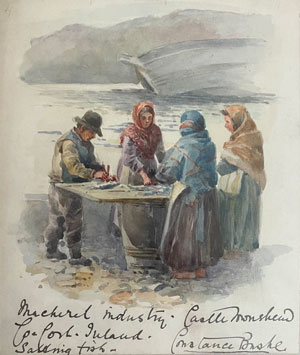Constance Bushe and mackerelsalting in West Cork
Published in Artefacts, Issue 1 (January/February 2024), Volume 32By Fintan Lane
At an art auction in Skibbereen last year I acquired a small watercolour painting (14cm x 12cm) that is a useful visual source for the working lives of fishing communities in nineteenth-century coastal West Cork. Inscribed underneath is the title: ‘Mackerel industry, Castletownshend, Co. Cork, Ireland, salting fish’. The painting probably dates from the 1870s, or maybe 1880. Later is less likely—the local-born artist was resident in England by early 1881.
The image is of three women and a man processing fish on a makeshift barrel-top table, with the man gutting the fish while the women salt. Instead of a pier, the work location is the stony shore, and in the background we see an abandoned wreck. The vivid colours of the women’s clothes are apparent in a way they never are in black-and-white photographs from the time; it is noticeable also that—unlike the man—at least two are barefoot. It’s a respectful portrayal of working people and caricature has been avoided.
The painting also highlights the strong involvement of women workers in the important mackerel industry of late nineteenth-century West Cork. The mackerel fishery of south-west Ireland grew in importance during the 1870s, and in 1881 it was noted that there were 737 mackerel boats operating in the region, although only 249 were Irish. Boats came from France, England and the Isle of Man. During the 1880s the industry expanded locally and nearby Baltimore became a key landing port.
Much of the fish caught was destined for export and, despite the rich harvest, it was observed in 1887 by Revd W.S. Green that very little fresh fish was consumed locally; the fishing communities in West Cork mostly ate salted and dried mackerel. The Inspectors of Irish Fisheries were critical of some of the methods used for curing, remarking in the late 1880s that locals ‘salt the fish in their cabins … in such an unscientific manner that the fish could not command a market on a large scale’. The salting portrayed in this painting is on a small scale and the fish could be intended for local consumption, although the bay was also a popular anchorage for French fishing-boats.
The artist, Constance Theodosia Bushe (c. 1843–1922), was born to Revd Charles Bushe and Emmeline Egerton Coghill in Castlehaven, the parish to which Castletownshend belongs. She was related to Sir Egerton Bushe Coghill, the Irish landscape artist, who was also from Castletownshend. The novelist Edith Somerville was her cousin and Bushe did a pastel portrait of her aged five.
Bushe was painting from an early age and her focus was on the people and landscapes of her locality. By her twenties she felt confident enough to exhibit and her work was positively received. At the third exhibition of the Irish Amateur Drawing Society, held in Carlow town in May 1872, she won second prize in the ‘Original Water Colour Landscapes’ section for a painting of Castletownshend harbour, which was deemed by the Carlow Sentinel to be ‘rather unpretentious, but decidedly meritorious’.
By 1881 Bushe had moved to London, where she stayed for a time with her younger sister, Josephine. Funded by annuities, she was residing in Wynnstay Gardens, South Kensington, by 1891 and lived there alone over the following decades. She continued to draw and paint, and her skilful coastal illustrations accompanied the verse of the late Horatius Bonar in a short book titled Cornish coves and corners (1891).
Bushe never married and died in Kensington aged 79 on 18 December 1922.
Fintan Lane is a historian with an interest in the social history of nineteenth-century Ireland.

















